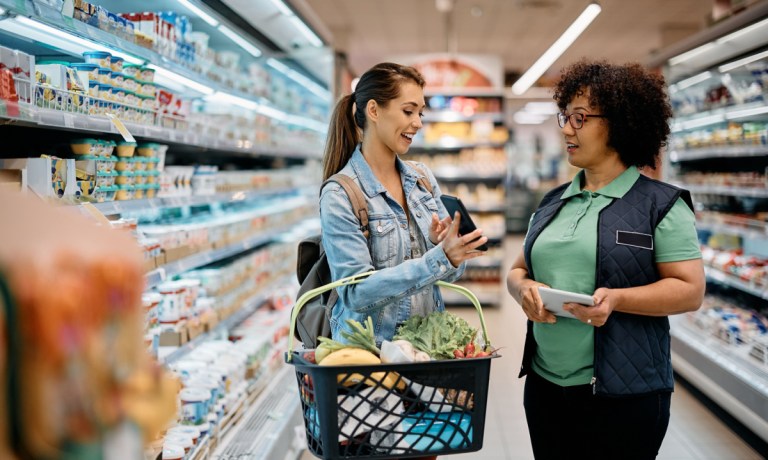
With the Digital Food & Beverage Conference kicking off Monday (June 12) in La Jolla, California, where industry executives gather to learn, among other subjects, about how to best leverage technology to drive loyalty, PYMNTS research reveals some of the key ways that grocers are harnessing their omnichannel platforms to keep consumers coming back.
Online coupons and rewards can be a powerful draw. According to research from PYMNTS’ study “Big Retail’s Innovation Mandate: Convenience and Personalization,” created in collaboration with ACI Worldwide, which draws from a survey of 300 retailers across the United States and the United Kingdom, 74% of grocers think consumers would be very or extremely likely to switch merchants if not offered the ability to use digital coupons and rewards.
For instance, membership-only warehouse chain BJ’s Wholesale Club has seen a widespread shift to digital coupon redemption.
“Those who engage with promotions spend the most. One way to look at this is percent of members who engage with a digital coupon,” CEO Bob Eddy told analysts on a call earlier this year. “Seventy percent of our coupons are now clipped digitally. This is up from 20% in 2019. Now, this drives loyalty because it is a much smoother way for us to deliver value to our members.”
Consumers want to pay how they want to pay. The same Big Retail’s Innovation Mandate study revealed that 68% of grocers believe that consumers would switch merchants without access to alternative payment methods in-store.
Take, for example, the United States’ leading pure-play grocer, Kroger, which after years of holding out (in an effort to drive adoption of its own mobile payment option, Kroger Pay) has caved to demand and begun accepting Apple Pay at certain locations.
Digital enables retailers to offer greater convenience to shoppers, a powerful draw. Research from PYMNTS’ study “Consumer Inflation Sentiment: The False Appeal of Deal-Chasing Consumers,” for which we surveyed more than 2,100 United States consumers in February, reveals that 77% of consumers cite ease/convenience as an important factor that influenced their decision of where to make their most recent grocery purchase.
Take, for instance, scan-and-go checkout options, which save grocery shoppers the wait in line. Instacart announced its first Scan & Pay checkout deployment earlier this year at Foodcellar Market, a grocer in Queens, New York.
“Our technology helps [grocers] provide a more convenient and delightful experience for their customers,” David McIntosh, vice president and general manager of Connected Stores at Instacart, said in a statement at the time. “[We’re] making it even easier for customers to get what they need, when they need it.”
Digital also enables grocers to offer consumers a wider range of fulfillment channels. The same Consumer Inflation Sentiment study found that more than one in five grocery shoppers cites pickup or delivery options as a key factor influencing merchant choice.
Walmart, for one, the world’s largest grocer, is seeing delivery demand drive digital engagement.
“eCommerce sales were led by continued double-digit growth in store-fulfilled pickup and delivery. Customers increasingly value convenience and speed of delivery,” Chief Financial Officer John Rainey said on the company’s most recent earnings call. “We have an advantage here as we leverage the proximity of our stores to fulfill and deliver digital orders to customer homes.”
Membership programs can go a long way towards keeping consumers coming back, with the majority of consumers now making at least some of their eCommerce purchases from retailers where they are members. According to a PYMNTS survey of nearly 2,700 U.S. consumers conducted in April, 61% of U.S. consumers are Amazon Prime members, and 26% are subscribed to Walmart+. Only 35% of consumers are not members of either service.
With these memberships driving food and beverage sales as well as retail, grocers are taking a tip. Kroger, for its part, is looking to hold its own by offering a lower-priced membership program.
“To provide even more value, we launched Boost, the industry’s most affordable membership nationwide in July,” Chairman and CEO Rodney McMullen told analysts on the company’s last earnings call. “Early results are exceeding our expectations with incremental engagement and overall household spend. We are evolving Boost with new benefits to further broaden its appeal and create additional customer value.”